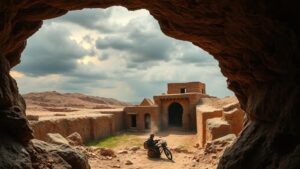Exploring the legends of Kalahari’s lost city, buried beneath the desert sands of Southern Africa.
Exploring the Legends of Kalahari’s Lost City
The Kalahari Desert, a vast expanse of arid land in Southern Africa, is home to rich folklore and intriguing tales about a legendary lost city said to be buried beneath its unforgiving sands. This article delves into the myths and historical accounts surrounding this enigma, the implications of its existence, and why it captures the imagination of explorers and historians alike.
The Origins of the Legend
The narrative surrounding the lost city of the Kalahari dates back centuries, with indigenous narratives and the accounts of early European explorers converging on a central theme: an ancient civilization that once thrived in this now-desolate region. According to local lore, the city was a vibrant hub of trade and culture, housing remarkable architectural feats that are now concealed beneath layers of sand.
One of the most well-known accounts comes from the early explorers in the late 19th century, particularly the Scottish missionary and explorer, F. E. B. H. Budden, who detailed in his journals interactions with local tribes. They spoke of a city that was majestic, adorned with gold and great wealth, which ultimately fell victim to environmental changes and was buried underground. Such stories ignited the imaginations of subsequent treasure hunters and historians.
Archaeological Evidence and Expeditions
There have been numerous expeditions aiming to uncover the lost city, the most notable being led by Dr. John W. T. M. DeMeyer during the early 21st century. DeMeyer and his team utilized modern archaeological techniques, such as ground-penetrating radar and satellite imagery, to search for signs of the alleged city.
These explorations yielded fragments of pottery and remnants of ancient tools, suggesting that there may have been human habitation in the Kalahari, confirming that this desolate region was not always devoid of life. In fact, anthropological studies indicate that the Kalahari has been inhabited by hunter-gatherer tribes for thousands of years, making it plausible that a more complex society once existed.
The Cultural Significance
The lost city legend serves a dual purpose for the native tribes–the San people and others in the region. It acts as a cautionary tale about the perils of pride and greed, while simultaneously preserving the rich history of their ancient ancestors. For example:
- The San people believe that the land retains the spirits of their ancestors, and that the lost city represents the consequences of forsaking traditional values.
- The tales of the lost city are used in cultural storytelling, reinforcing tribal unity and education about their heritage.
Modern Interpretations and Theories
Today, various theories exist about the origin of the lost city legend. Some suggest it symbolizes humanitys quest for wealth and the ensuing environmental degradation that leads to the collapse of civilizations. Others believe it may stem from a genuine historical event linked to ancient societies. For example:
- Atlantis Analogies: Much like the myth of Atlantis, the lost city in the Kalahari evokes themes of lost civilizations that possess sophisticated knowledge and culture.
- Environmental Change: Some environmental scientists argue that climatic shifts (such as the transition from wetter to drier conditions) could have compelled early inhabitants to abandon settlements, feeding into the legend of a lost city.
Real-World Applications
The exploration of the Kalahari’s lost city has broader implications for conservation efforts and understanding environmental changes. As scientists study artifacts and geological shifts, they glean insights into historical climate variations and human adaptation strategies. By understanding these patterns, contemporary societies can better prepare for potential environmental challenges.
Conclusion: The Legacy of the Lost City
The legend of Kalahari’s lost city represents more than just an archaeological mystery; it embodies the rich tapestry of human experience. Whether rooted in fact or folklore, the stories capture the essence of cultural identity and environmental stewardship. For explorers, historians, or simply those captivated by the narrative, the lost city remains a powerful symbol of what was and what might yet be discovered beneath the sands of the Kalahari.
Actionable Takeaways
- Further research is encouraged for individuals interested in the intersections of archaeology, anthropology, and environmental science.
- Supporting organizations focused on the preservation of cultural heritage in Southern Africa can help protect the stories and legacies of indigenous peoples.
- Engaging in local tourism that emphasizes cultural education can contribute to the sustainability of these historical sites.


